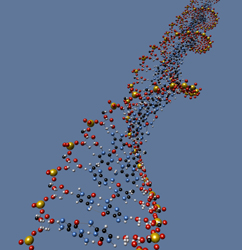DNA-based nanoelectronics
The DNA BASED NANOWIRES project, involving an international consortium of seven universities and research centres, was founded by the Fifth Framework Programme to search for an alternative to silicon-based microelectronics. DNA and its derivatives enable packing of enormous densities of information and more importantly, can be accurately synthesised as well as manipulated. The ultimate aim of the project partners, led by Tel Aviv University was to develop DNA-based conductive nanowires for nanoelectronic devices. DNA is in itself probably not a good conductor and a molecular wire is characterised by limited ability to transport electrical charges. However, DNA-based structures such as G4-DNA may offer the desired conductive properties. G4-DNA is a highly stable DNA molecule made of consecutive planar arrangements of four guanine (dG) bases, connected with poly-dG strands and stabilised by metal ions. Experimental and theoretical research groups with Tel Aviv University succeeded in producing a novel G4-DNA nanowire that showed encouraging conductivity signals, while preserving recognition and specific structuring qualities. The method proposed for synthesising a one-to-one double helical complex of two polydeoxyguanylate (poly(dG)) and polydeoxycytidylate (poly(dC)) strands yielded a uniform polymer with a high guanine content. Guanine, with the lowest ionisation potential among DNA bases, promoted electric charge transport and made the polymer a good candidate for use in nanoelectronics. A detailed description of the enzymatic synthesis of the poly(dG) - poly(dC) molecules of controllable quality and length ranging between hundreds of nanometres up to micrometres has been made publicly available. The article published in the peer-reviewed ´Nucleid Acids Research' journal is freely available.







